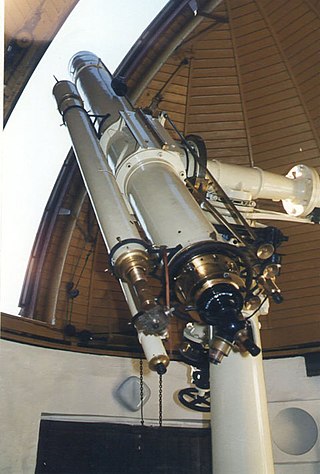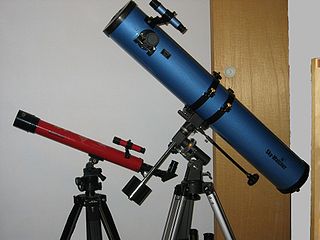Related Research Articles

Yerkes Observatory is an astronomical observatory located in Williams Bay, Wisconsin, United States. The observatory was operated by the University of Chicago Department of Astronomy and Astrophysics from its founding in 1897 until 2018. Ownership was transferred to the non-profit Yerkes Future Foundation (YFF) in May 2020, which began millions of dollars of restoration and renovation of the historic building and grounds. Yerkes re-opened for public tours and programming in May, 2022. The April, 2024 issue of National Geographic magazine featured a story about the Observatory and ongoing work to restore it to relevance for astronomy, public science engagement and exploring big ideas through art, science, culture and landscape. The observatory offers tickets to programs and tours on its website.

A refracting telescope is a type of optical telescope that uses a lens as its objective to form an image. The refracting telescope design was originally used in spyglasses and astronomical telescopes but is also used for long-focus camera lenses. Although large refracting telescopes were very popular in the second half of the 19th century, for most research purposes, the refracting telescope has been superseded by the reflecting telescope, which allows larger apertures. A refractor's magnification is calculated by dividing the focal length of the objective lens by that of the eyepiece.

A Dobsonian telescope is an altazimuth-mounted Newtonian telescope design popularized by John Dobson in 1965 and credited with vastly increasing the size of telescopes available to amateur astronomers. Dobson's telescopes featured a simplified mechanical design that was easy to manufacture from readily available components to create a large, portable, low-cost telescope. The design is optimized for observing faint, deep-sky objects such as nebulae and galaxies. This type of observation requires a large objective diameter of relatively short focal length and portability for travel to less light-polluted locations.

The Newtonian telescope, also called the Newtonian reflector or just a Newtonian, is a type of reflecting telescope invented by the English scientist Sir Isaac Newton, using a concave primary mirror and a flat diagonal secondary mirror. Newton's first reflecting telescope was completed in 1668 and is the earliest known functional reflecting telescope. The Newtonian telescope's simple design has made it very popular with amateur telescope makers.
A small telescope is generally considered by professional astronomers to be any reflecting telescope with a primary mirror that is less than 2 metres (80 in) in diameter. By amateur standards, a small telescope can have a primary mirror/aperture less than 6–10 inches (150–250 mm) in diameter. Little if any professional-level research is performed with refracting telescopes in the modern era of astronomy.

An equatorial mount is a mount for instruments that compensates for Earth's rotation by having one rotational axis, called polar axis, parallel to the Earth's axis of rotation. This type of mount is used for astronomical telescopes and cameras. The advantage of an equatorial mount lies in its ability to allow the instrument attached to it to stay fixed on any celestial object with diurnal motion by driving one axis at a constant speed. Such an arrangement is called a sidereal drive or clock drive. Equatorial mounts achieve this by aligning their rotational axis with the Earth, a process known as polar alignment.

A catadioptric optical system is one where refraction and reflection are combined in an optical system, usually via lenses (dioptrics) and curved mirrors (catoptrics). Catadioptric combinations are used in focusing systems such as searchlights, headlamps, early lighthouse focusing systems, optical telescopes, microscopes, and telephoto lenses. Other optical systems that use lenses and mirrors are also referred to as "catadioptric", such as surveillance catadioptric sensors.

The Maksutov is a catadioptric telescope design that combines a spherical mirror with a weakly negative meniscus lens in a design that takes advantage of all the surfaces being nearly "spherically symmetrical". The negative lens is usually full diameter and placed at the entrance pupil of the telescope. The design corrects the problems of off-axis aberrations such as coma found in reflecting telescopes while also correcting chromatic aberration. It was patented in 1941 by Soviet optician Dmitri Dmitrievich Maksutov. Maksutov based his design on the idea behind the Schmidt camera of using the spherical errors of a negative lens to correct the opposite errors in a spherical primary mirror. The design is most commonly seen in a Cassegrain variation, with an integrated secondary, that can use all-spherical elements, thereby simplifying fabrication. Maksutov telescopes have been sold on the amateur market since the 1950s.
Celestron, LLC is a company that manufactures telescopes and distributes telescopes, binoculars, spotting scopes, microscopes, and accessories manufactured by its parent company, the Synta Technology Corporation of Taiwan.

The Cassegrain reflector is a combination of a primary concave mirror and a secondary convex mirror, often used in optical telescopes and radio antennas, the main characteristic being that the optical path folds back onto itself, relative to the optical system's primary mirror entrance aperture. This design puts the focal point at a convenient location behind the primary mirror and the convex secondary adds a telephoto effect creating a much longer focal length in a mechanically short system.

An astrograph is a telescope designed for the sole purpose of astrophotography. Astrographs are mostly used in wide-field astronomical surveys of the sky and for detection of objects such as asteroids, meteors, and comets.
Tele Vue Optics is a Chester, New York-based astronomical optics company known primarily for its premium brand of speciality eyepieces and apochromatic refractor telescopes. Founded in 1977 by Al Nagler, an optical engineer from The Bronx who designed simulators used in the Apollo program, the company originally made projection lenses for large projection-screen televisions, but is well known in the astronomy community for its products.
Questar Corporation is a company based in New Hope, Pennsylvania. It manufactures precision optical devices for consumer, industrial, aerospace, and military markets. Its telescopes produced for the consumer market are sold under the brand name "Questar".
Orion Telescopes & Binoculars is an American retail company that sells telescopes, binoculars and accessories online and in-store for astronomy and birdwatching. It was founded in 1975 and has corporate offices in Watsonville, California. A large proportion of its products are manufactured by the Chinese company Synta for the Orion brand name. Orion Telescopes & Binoculars ships its products to the United States and over 20 other countries. Orion puts out a semi-quarterly mail-order catalog as well as email catalogs. The company is a prominent advertiser in North American astronomy magazines, such as Sky & Telescope and Astronomy.

Sky-Watcher is a commercial distribution company established in 1999 by the Synta Technology Corporation of Taiwan. It markets telescopes and astronomy equipment, such as mounts and eyepieces, aimed at the amateur astronomy market. The products are manufactured at Synta Taiwan's Suzhou Synta Optical Technology Co., Ltd. in Suzhou (Jiangsu), China. The brand is distributed in Canada, Europe and in the late 2000s, it was extended to the United States market.

The Astroscan was a wide-field 4⅛" clear-inch (105mm) diameter reflecting telescope, originally produced by the Edmund Scientific Corporation, that was for sale from 1976 to 2013.

RC Optical Systems was a high-end American telescope and optics manufacturer that specialized in Ritchey-Chrétien telescopes with hyperbolic mirrors. RC also made related mounts and systems for the telescopes, with a focus on open and closed carbon fiber trusses for low expansion. The basic Ritchey-Chrétien optical system uses two mirrors and no refracting elements, which reduces light loss and its optical characteristics make it popular for astrophotography. Refracting elements may be added to correct for field curvature.

Great refractor refers to a large telescope with a lens, usually the largest refractor at an observatory with an equatorial mount. The preeminence and success of this style in observational astronomy defines an era in modern telescopy in the 19th and early 20th century. Great refractors were large refracting telescopes using achromatic lenses. They were often the largest in the world, or largest in a region. Despite typical designs having smaller apertures than reflectors, great refractors offered a number of advantages and were popular for astronomy. It was also popular to exhibit large refractors at international exhibits, and examples of this include the Trophy Telescope at the 1851 Great Exhibition, and the Yerkes Great Refractor at the 1893 World's Fair in Chicago.

The Greenwich 28-inch refractor is a telescope at the Royal Observatory, Greenwich, where it was first installed in 1893. It is a 28-inch ( 71 cm) aperture objective lens telescope, otherwise known as a refractor, and was made by the telescope maker Sir Howard Grubb. The achromatic lens was made Grubb from Chance Brothers glass. The mounting is older however and dates to the 1850s, having been designed by Royal Observatory director George Airy and the firm Ransomes and Simms. The telescope is noted for its spherical dome which extends beyond the tower, nicknamed the "onion" dome. Another name for this telescope is "The Great Equatorial" which it shares with the building, which housed an older but smaller telescope previously.
References
- 1 2 3 Gary, Alex (2006-10-26). "High-end telescope maker goes under microscope". Rockford Register Star . Archived from the original on 2024-05-27. Retrieved 2014-12-26.
- ↑ Mollise, Rod (2009). Choosing and Using a New CAT: Getting the Most from Your Schmidt Cassegrain or Any Catadioptric Telescope. New York: Springer Science+Business Media. p. 107. ISBN 978-0-387-09772-5 . Retrieved 2014-12-31.
Astro-Physics (A-P) is almost legendary in the amateur astronomy community, mainly because of the outstanding apochromatic refractors this Illinois company produces.
- 1 2 3 Harrington, Philip S. (2011-02-05). Star Ware: The Amateur Astronomer's Guide to Choosing, Buying, and Using Telescopes and Accessories (4 ed.). Hoboken, New Jersey: John Wiley & Sons. p. 96. ISBN 978-0471750635 . Retrieved 2014-12-26.
- ↑ English, Neil (2012-08-30). Classic Telescopes: A Guide to Collecting, Restoring, and Using Telescopes of Yesteryear. New York: Springer Science+Business Media. pp. 184–185. ISBN 978-1461444237 . Retrieved 2014-12-26.
- ↑ "Astro-Physics to be profiled on TV show". Rockford Register Star . 2006-10-25. Archived from the original on 2024-05-27. Retrieved 2014-12-26.
- ↑ "Get a closer look at the heavens with telescope made here". Rockford Register Star . 2006-07-20. Archived from the original on 2024-05-27. Retrieved 2014-12-26.